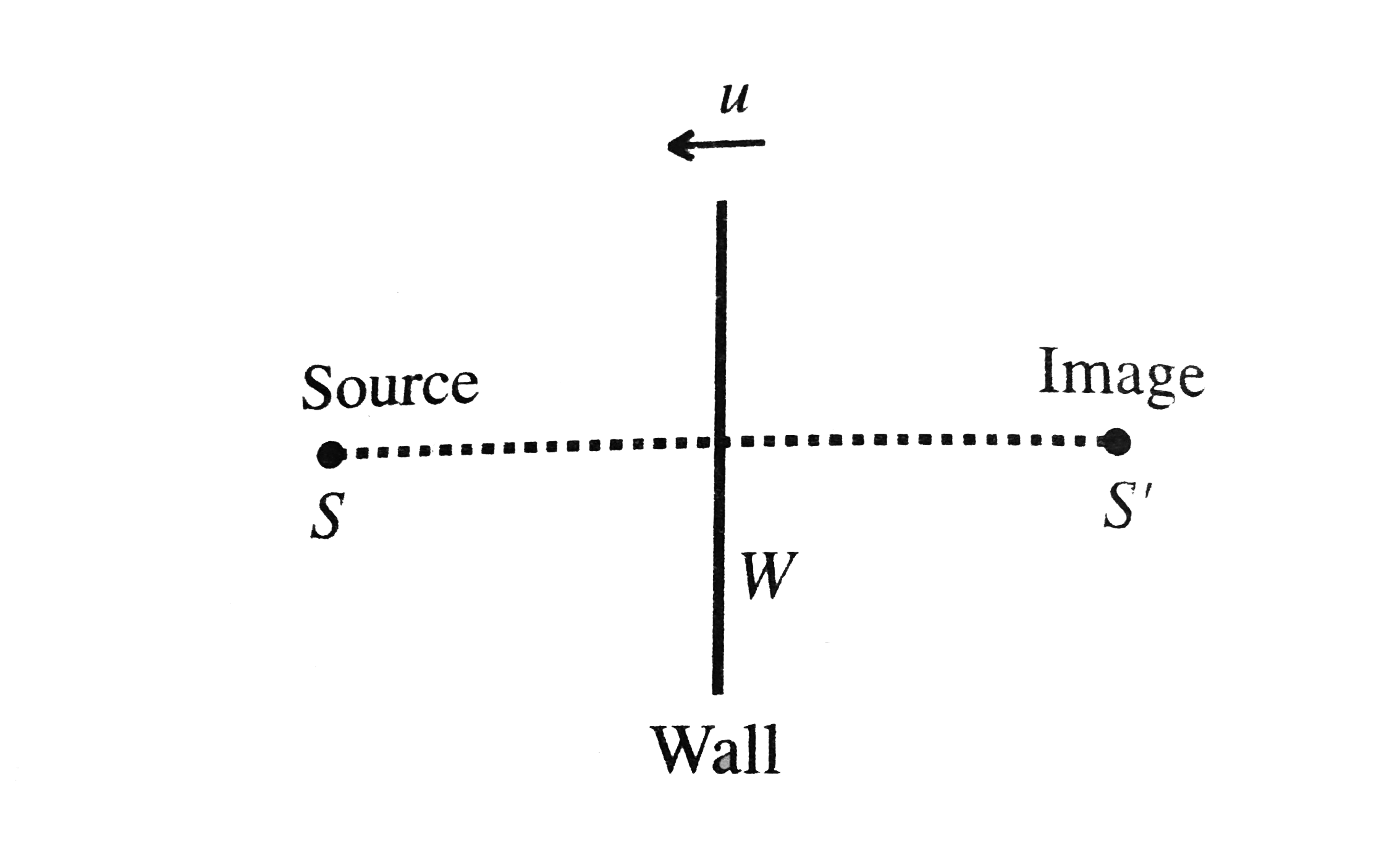A stationary source sends forth monochromatic sound. A wall approaches it with velocity 33 cm/s. The propagation velocity of sound in the medium is . How much, in per cent , does the wavelength of sound change on reflection from the wall?
To find the percentage change in the wavelength of sound when it reflects off a wall approaching a stationary source, we can follow these steps:
Step 1: Understand the Problem
We have a stationary sound source and a wall moving towards it with a velocity of 33 cm/s. The speed of sound in the medium is given as 330 m/s. We need to find the percentage change in the wavelength of the sound upon reflection from the wall.
Step 2: Convert Units
Convert the velocity of the wall from cm/s to m/s:
vw=33 cm/s=0.33 m/s
Step 3: Use the Wave Equation
The speed of sound c is related to wavelength λ and frequency ν by the equation:
c=λν
Since the frequency remains constant, we can express the relationship for the initial and reflected wavelengths:
cλ1=c′λ2
Step 4: Determine Effective Velocities
When the wall approaches the source, the effective speed of sound relative to the wall is:
- For the initial wavelength λ1:
c′=c−vw=330 m/s−0.33 m/s=329.67 m/s
- For the reflected wavelength λ2:
c′=c+vw=330 m/s+0.33 m/s=330.33 m/s
Step 5: Set Up the Ratio of Wavelengths
From the wave equation, we can set up the ratio:
λ1λ2=c+vwc−vw
Substituting the values:
λ1λ2=330.33329.67
Step 6: Calculate the Ratio
Calculating the ratio:
λ1λ2≈1.002
Step 7: Express Wavelengths in Terms of Each Other
From the ratio, we can express:
λ1=1.002λ2
Step 8: Calculate Percentage Change
To find the percentage change in wavelength:
Percentage Change=λ1−λ2λ1×100
Substituting the values:
Percentage Change=1.002λ2−λ21.002λ2×100
This simplifies to:
Percentage Change=0.002λ21.002λ2×100≈0.1996×100≈1.996%
Final Answer
The percentage change in the wavelength of sound on reflection from the wall is approximately 1.996%.
---
We have a stationary sound source and a wall moving towards it with a velocity of 33 cm/s. The speed of sound in the medium is given as 330 m/s. We need to find the percentage change in the wavelength of the sound upon reflection from the wall.
Convert the velocity of the wall from cm/s to m/s:
vw=33 cm/s=0.33 m/s
The speed of sound c is related to wavelength λ and frequency ν by the equation:
c=λν
Since the frequency remains constant, we can express the relationship for the initial and reflected wavelengths:
cλ1=c′λ2
When the wall approaches the source, the effective speed of sound relative to the wall is:
- For the initial wavelength λ1:
c′=c−vw=330 m/s−0.33 m/s=329.67 m/s
c′=c+vw=330 m/s+0.33 m/s=330.33 m/s
From the wave equation, we can set up the ratio:
λ1λ2=c+vwc−vw
Substituting the values:
λ1λ2=330.33329.67
Calculating the ratio:
λ1λ2≈1.002
From the ratio, we can express:
λ1=1.002λ2
To find the percentage change in wavelength:
Percentage Change=λ1−λ2λ1×100
Substituting the values:
Percentage Change=1.002λ2−λ21.002λ2×100
This simplifies to:
Percentage Change=0.002λ21.002λ2×100≈0.1996×100≈1.996%
The percentage change in the wavelength of sound on reflection from the wall is approximately 1.996%.
Topper's Solved these Questions
- SOUND WAVES AND DOPPLER EFFECTBOOK - CENGAGE PHYSICS ENGLISHCHAPTER - SOUND WAVES AND DOPPLER EFFECTEXERCISE - Subjective
56 Videos
- SOUND WAVES AND DOPPLER EFFECTBOOK - CENGAGE PHYSICS ENGLISHCHAPTER - SOUND WAVES AND DOPPLER EFFECTEXERCISE - Single Correct
252 Videos
- SOUND WAVES AND DOPPLER EFFECTBOOK - CENGAGE PHYSICS ENGLISHCHAPTER - SOUND WAVES AND DOPPLER EFFECTEXERCISE - Exercise 6.1
56 Videos
- RIGID BODY DYNAMICS 2BOOK - CENGAGE PHYSICS ENGLISHCHAPTER - RIGID BODY DYNAMICS 2EXERCISE - Interger
2 Videos
- SUPERPOSITION AND STANDING WAVESBOOK - CENGAGE PHYSICS ENGLISHCHAPTER - SUPERPOSITION AND STANDING WAVESEXERCISE - Comprehension Type
5 Videos
Similar Questions
Two waves of wavelengths 99 cm and 100 cm produce 4 beats per second. Velocity of sound in the medium is
View Solutionif the velocity of sound in helium at room temperature is 330 m/s, then the velocity of sound in hydrogen is
View Solution A driver in a stationary car horns which produces monochromatic sound waves of frequency n=1000Hz, normally towards a reflecting wall. If the wall approaches the car will a velocity u=3.3ms, calculate the frequency of sound reflected from wall and heard by the driver. What is the percentage change of sound frequency of reflection from the wall?
A driver in a stationary car horns which produces monochromatic sound waves of frequency n=1000Hz, normally towards a reflecting wall. If the wall approaches the car will a velocity u=3.3ms, calculate the frequency of sound reflected from wall and heard by the driver. What is the percentage change of sound frequency of reflection from the wall?
View SolutionA source of sound produces waves of wavelength 60 cm when it is stationary if the speed of sound in air is 320ms and source moves with speed 20ms, the wavelength of sound in the forward direction will be nearest to
View SolutionTwo sound waves of wavelength 1 m and 1.02 m produces 16 beats in 2 s in a medium then the velocity of the sound in that medium is
View SolutionCalculate the increase velocity of sound for 1∘C rise of temperature if the velocity of sound at 0∘C is 332ms.
View SolutionVelocity of sound in a medium is 490m/s. two waves of wavelength 98 cm and 100 cm are superposed. Calculate the beat frequency.
View SolutionTwo sound waves of wavelength 1m and 1.01m in a gas produce 10 beats in 3s. The velocity of sound in the gas is
View SolutionThe velocity of sound in air at NTP is 330 m/s. What will be its value when temperature is doubled and pressure is halved ?
View SolutionThe velocity of sound in air at 27∘C is 330 m/s. the velocity of sound when the temperature of the gas is raised to 227∘C is
View Solution
